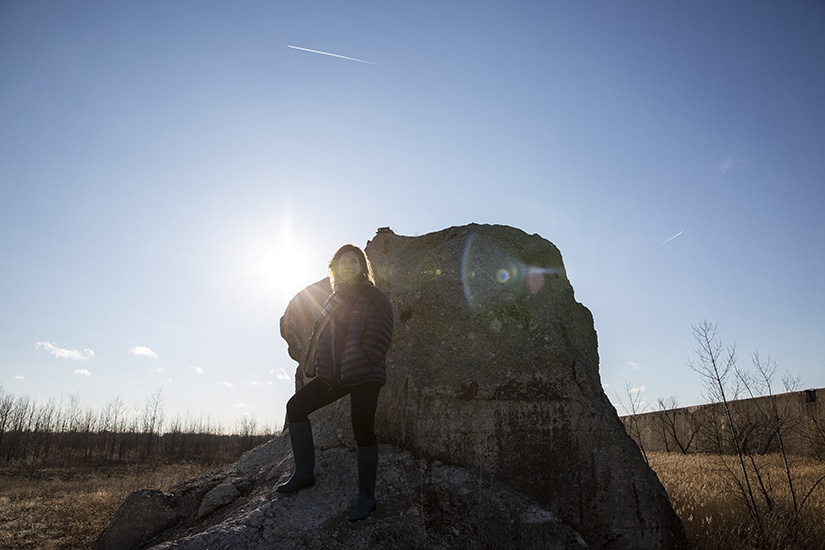|
|
Perhaps inspired by Aesop’s “The Town Mouse and the Country Mouse” fable, humans have often drawn distinct lines between what belongs in cities and what is found in the country. But let’s not overlook how rodents and many other animals make their homes in urban and rural areas. Surprising to many is how in a place like Chicago, roughly 300 species of migratory birds make a stopover along a narrow strip of land, known as The Burnham Wildlife Corridor, in close proximity to downtown.
About 20 miles south of this urban habitat is the Indian Boundary Prairies, a cluster of four remnant grasslands that hold a rich diversity of plant, insect, and bird species on 370 acres of grassland. It’s just one of 100 parcels of land under the protection of The Nature Conservancy (TNC) Illinois, and still within the Chicago metro region that is home to 9.5 million people.

Michelle Carr, state director of TNC Illinois Chapter, emphasizes how the preservation of natural ecosystems is beneficial to the human species as much as those of the plant and animal kingdoms. She suggests it makes the city more attractive to businesses and the talent they need to draw into their employ.
“The best and the brightest people want to live and work where things are attractive, breathable, beautiful—and not flooded,” says Carr, in reference to the problem affecting many cities where the hard surfaces of built environments mean stormwater has nowhere to go. Formerly the Goldman Sachs vice president, Carr made an abrupt career change in 2013 after an epiphany on the dire nature of climate change. This previous role informed the way that she continues to invest, but now the investments are in nature.
Chicago is basically a wetland that is mostly long paved over. Its buildings and streets divert rainstorm runoff to sewers and to massive water treatment facilities, while overflows back up into basements and spill into natural waterways. Suburban developments, commercial properties in particular, aren’t much better. “We need strategic places to hold and filter stormwater runoff,” says Carr, indicating the value of prairies and wetlands, which filter water as it sinks to recharge the underground aquifer. “They are the kidneys of the system.”
Parks and forest preserves, along with green infrastructure like rain gardens, are critical for reducing urban flooding. But it’s the natural prairies that once covered the state that do the best job of this. Looking at the many sites under Nature Conservancy protection in Illinois as well as in nearby Indiana and Wisconsin, it’s easier to understand the functional value of natural landscapes.
One such location is Nachusa Grasslands, which is home not only to rare and unusual species of turtles and grassland birds (grasshopper sparrows, dickcissels, and Henslow’s sparrows among them), as well as 700 native plant species, but also a relocated herd of bison. From 30 bison reintroduced in 2014, the huge animals now number more than 100, living within the 1,500 acres of this fenced preserve in Franklin Grove, Illinois, about 100 miles west of Chicago.

A bit south and within 60 miles of the Windy City is the Midewin National Tallgrass Prairie, which is owned by the US Forest Service and shared with TNC through a partnership that executes the preserve’s robust volunteer program. Established on the site of a former military arsenal and adjacent farmland, it features 20,000 acres of restored tallgrass prairie, the largest such tract east of the Mississippi. Providing sufficient space for species that require wide-open spaces, it has areas designated for biking, hiking, dog walking, and horseback riding, and like Nachusa, bison have been reintroduced to help restore natural tallgrass conditions.
In Lexington, Illinois, 120 miles southwest of the city, The Franklin Research and Demonstration Farm, also a Nature Conservancy project, is a model of sustainable agriculture. That means planting covers crops (oats, radish, and cereal rye) that stabilize soil during the winter while replenishing soil nutrients. Also, constructed wetlands adjacent to the agricultural land capture nutrient runoff (e.g., concentrated nitrogen and phosphorous, otherwise harmful to downstream marine life) while providing habitats for birds, plants, and wildlife.
Keep in mind it was Midwestern agriculture, producing commodities such as butter, eggs, pork bellies, corn, and soy, that created the Chicago Board of Trade and Chicago Mercantile Exchange in the 19th century.

Carr’s work and that of her colleagues wins the hearts and minds of elected officials, who play a big role in how these areas are restored and protected. “We get them to touch and feel the sites in their jurisdiction,” she says. That same tactile-sensory relationship with ecosystems forms future environmentalists as well. “When schoolchildren get their hands in the dirt, when they see pollinators and learn how food is dependent on them, it sparks wonder.”
With several such locations within a day’s field trip of Chicago-area schools, those kinds of educational experiences are accessible to students who otherwise see a lot more concrete than tallgrass.
Aesop portrayed differences between towns and country. But as long as city kids learn how to avoid riling up bees and bison, they’re more likely to linger and learn than hightail it back to town.


